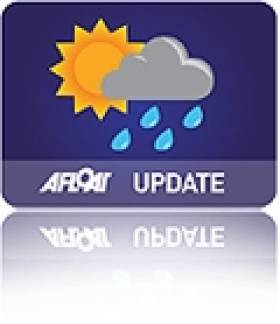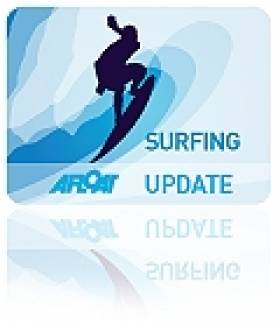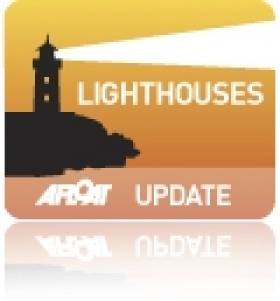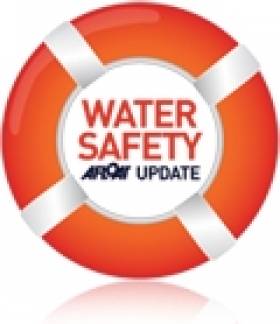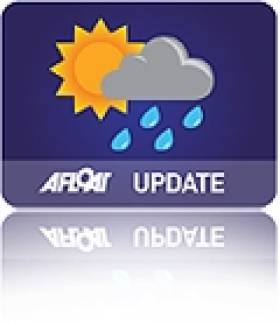Displaying items by tag: Weather
Cork & Kerry Braced For Storm-Force Winds As 'Status Red' Declared
#WeatherWarning - Cork and Kerry are currently under a Status Red weather warning from Met Éireann as wind speeds rise to as much as 85km/h with gusts threatening to hit an incredible 160km/h by this afternoon (Wednesday 12 February).
Meanwhile an Orange alert has been issued for Wexford, Galway, Mayo, Clare, Limerick and Waterford and for mariners on all coasts, with gusts of up to 130km/h expected in the coming hours as the latest in an unusually persistent succession of storms sweeps in from the Atlantic.
And it seems no part of the country will be spared from the wind assault, with Status Yellow (for winds justing 100 to 110km/h) declared for most other counties.
TheJournal.ie reports that the high winds and seas will be accompanied by rain, sleet and snow, with thundery showers and spot flooding a possibility.
Rowing Hit by Weather Again as St Michael's Head Postponed
ROWING: The St Michael’s head of the river, which was to be held this Saturday, February 1st, has been postoned for three weeks. The organisers say that he forecast of “very severe” weather prompted the move. The rescheduled head will be on February 22nd. Plans to hold the Kerry and Sligo heads of the river also fell to poor weather earlier this month.
Severe Weather Alert Issued By Clare County Council
#weatherwarning – Clare County Council has issued a flood and storm warning for the entire county in advance of severe weather conditions that are expected during the next few days.
The local authority is urging land, home and business owners, particularly those in low lying coastal areas, to take precautionary steps in light of the flood risk posed by a combination of heavy rainfall, strong gale to storm force winds, a large sea swell and a Spring Tide.
"There is a serious risk countywide of both coastal and inland flooding and all areas which have flooded in the past could be seriously impacted. Conditions could be similar in nature and extent to the storm events of early January with the potential for structural damage," explained Tom Tiernan, Senior Engineer, Clare County Council.
He added: "Current firm indications are that severe weather conditions will pertain throughout the coming weekend commencing with a substantial rainfall event tomorrow (Friday). In addition, tide levels will be rising to a Spring Tide peak overnight on Friday/Saturday morning. This will be exacerbated by significant swell conditions and high Westerly and South Westerly winds which will continue through Saturday."
Mr. Tiernan confirmed that river levels remain "very high", and arrangements have been put in place to continuously monitor the situation.
He continued: "Clare County Council, in conjunction with the Emergency Services, is progressing contingency arrangements in terms of additional pumping capacity and other flood alleviation measures at flood prone locations. In the meantime, the advice is to take appropriate precautions and not to venture out unless necessary, particularly in coastal areas."
Flooding advice is available on www.flooding.ie . Information included on the website includes advice on identifying flooding risks, protecting property against flooding, necessary steps to be taken if a property is flooded, and assessing and repairing property damaged by flooding.
New Pocket-Sized Weather Guide For Coastal & Offshore Sailors
#Weather - Reeds Weather Handbook for Sail and Power is an essential pocket-sized guide that every coastal and offshore boater will want for their next trip.
Author Frank Singleton takes a practical approach, with plenty of clear diagrams to help you understand the weather and what it means for your sailing.
Reeds Weather Handbook is available from Amazon and all good nautical bookshops.
#Surfing - Though the recent spate of Atlantic storms have made things difficult for inshore fishermen and devastated coastal areas throughout the country, one contingent that's been welcoming the wind is the world's big wave surfing community.
As The Irish Times reports, 20-metre waves were not uncommon as the Atlantic 'black swell' that swept in with what was dubbed Storm Christine crashed on the shores of Western Europe, and attracted the cream of Ireland's and the world's surfers to the north-west.
Mullaghmore Head, which made the list of Surfer Today's best European big wave surf spots along with Aileens off the Cliffs of Moher, was producing waves on Monday morning described as "too big to tackle" by the Irish Independent.
And first to the Sligo surf was American boarder Kurt Rist, according to Surfer Today, which notes that Belharra in south-west France was another big meeting point for the pros.
The surf at Mullaghmore was even strong enough to snap the board of Irish Surfing Association chair Henry Moore, who got a bloody nose for his troubles yet still sang the praises of the conditions that "put Ireland on the big wave surfing map and that's why so many people have flown in from France, the USA, Germany, Spain and Portugal."
Visitor numbers in Ireland's top west coast surfing haunts were up thanks to the recent Atlantic swell, though at least one local hotelier was caught out as he closed up shop for a fortnight just before the big waves hit - more on that story in the Irish Independent HERE.
Six Lighthouses Damaged But Still Operational As Country Counts Cost Of Storm Damage
#Lighthouses - Six lighthouses around the Irish coast were damaged by this week's stormy weather but remained operational, as The Irish Times reports.
The Commissioners of Irish Lights has since begun an aerial inspection of the coastline from Tuskar Rock off Wexford to Inishtrahull in Donegal to assess the extend of structural damage as hurricane-strength winds and massive surf assaulted the island of Ireland.
Worst affected as the lighthouse on Inis Oírr in the Aran Islands, where windows were blown in and a perimeter wall was collapsed.
Meanwhile, an approach light on Inishbofin off Connemara that was blown away in the storms will be replaced by a temporary battery-operated lantern.
The extreme conditions are also thought to be responsible for two fatal dolphin strandings in the Galway region, in Salthill close to the city and Roundstone in western Connemara.
The Irish Times has much more on the story HERE.
Water Safety Warnings Repeated After Man Caught By Wave In Howth
#WaterSafety - The public has been reminded yet again to stay away from the water's edge as the country continues to be battered by huge waves and storm-force winds after a man was injured on Howth's East Pier this afternoon (6 January).
As TheJournal.ie reports, the man was caught by a wave while walking along the upper portion of the North Dublin pier and thrown some 10 feet to the lower section, injuring his ankle in the fall.
The man has ventured onto the wave-lashed pier despite widespread warnings to the public from the Irish Coast Guard and Irish Water Safety to keep a good distance from the water during this latest orange alert weather warning from Met Éireann.
Coastguard chiefs have reiterated last week's appeal by Irish Water Safety for people to stay away from waterside areas until the current series of storms and high tides has passed.
Last week Waterways Ireland also warned of the dangers posed by rising tides in inland harbours and waterside areas as flooding persists in various spots nationwide.
Flood Alerts In Galway And Cork As Stormy Weather Returns
#Weather - RTÉ News says flood alerts have been issued for Galway and Cork as more stormy weather sweeps in from the Atlantic this evening (2 January).
Western and southern areas will be worst affected, with Met Éireann declaring Status Orange for Donegal, Clare, Connacht, Limerick, Kerry and Cork.
Wind speeds in these areas this evening and tonight may reach 90km/hr with gusts of up to 130km/hr along with heavy rain, high tides and high seas, which presents a flooding risk in coastal areas that may remain till this Sunday 5 January.
Cavan, Monaghan, Tipperary, Waterford and Leinster counties should expect winds of up to 80km/hr with 110km/hr gusts with similar coastal flooding risks.
Meanwhile, Met Éireann has declared a Status Orange marine warning for south to south-east gales expected to develop later today on all Irish coastal eaters and on the Irish Sea.
These winds will range from gale to storm force in all sea areas tonight, with "violent storm force" winds on the north-west coast.
Coastal and waterside areas throughout the UK are also on alert for this new wave of "exceptional weather", especially in Devon and Cornwall where waves were reaching nine metres in some spots this afternoon.
UPDATED: Weather Warning For St Stephen's Day As Storm-Force Winds Sweep In
#Weather - Met Éireann has announced a national weather warning is in effect from later today (26 December) as storm-force winds are expected to reach speeds as high as 130km/hr in coastal areas.
UPDATE: As of late this morning, the weather warning level has been raised to RED with severe and damaging gusts of 120 to 140km/hr expected and 150km/hr gusts in exposed coastal areas. There is also a risk of very high seas with significant danger of coastal flooding.
The wind warning comes into effect from 5pm this evening and continues overnight and into tomorrow afternoon at 3pm.
As TheJournal.ie reports, ferry sailings have already been cancelled, and small craft are advised of the status level of 'Orange' as southerly winds are expected to increase to gale or strong gale force this afternoon on all coasts of Ireland and on the Irish Sea, and will veer southwest to west tonight while increasing to storm force at times.
Pre-Christmas Present For Surfers On Ireland's West Coast
#Surfing - Surfers in the West of Ireland will be on standby this week as the latest weather forecasts show a significant swell heading our way across the Atlantic.
According to Surf-Forecast.com, the coastline is already set to experience wave heights of 5 metres or more this afternoon (Sunday 15 December).
But the best may be yet to come, with swells expected to nearly double that height by Thursday (19 December).
And the big wave bounty looks to continue into the following week, providing plenty of opportunity for Ireland's swellseekers to catch a monster before Christmas!




























